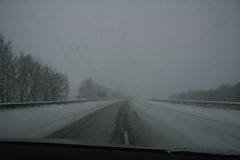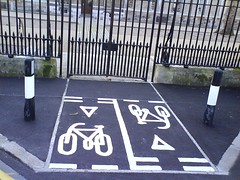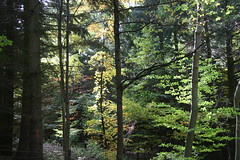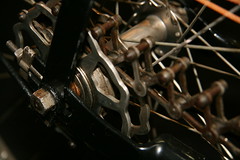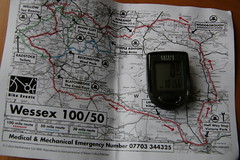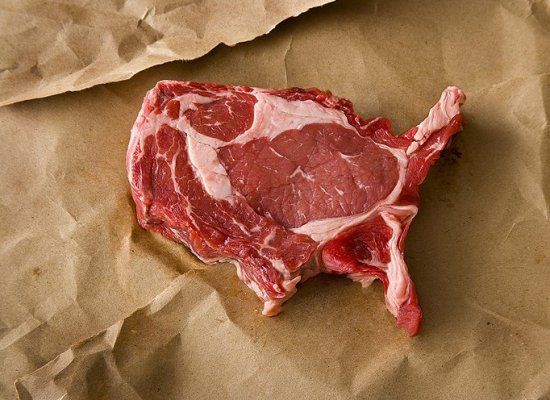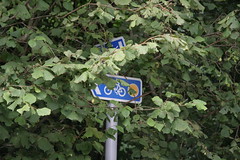Thursday 31 December 2009
It's a roll-over
Saturday 26 December 2009
Golden Wheels
 A few weeks before Christmas, the Bike show pointed to Tim Dawson's Cycling Books website, which includes a review of The Golden Wheels of Albert Winstanley. That review got the book added to my Christmas list, but since it was published in 1985, I didn't hold out much hope. However, my wife found it somewhere on the Interweb, and it was among the presents that I unwrapped yesterday morning.
A few weeks before Christmas, the Bike show pointed to Tim Dawson's Cycling Books website, which includes a review of The Golden Wheels of Albert Winstanley. That review got the book added to my Christmas list, but since it was published in 1985, I didn't hold out much hope. However, my wife found it somewhere on the Interweb, and it was among the presents that I unwrapped yesterday morning.Sunday 20 December 2009
M6
The weather forecast wasn't good, but I worked out that if I took the more westerly route on the way up I would avoid the worst of the weather, and that worked out OK. Coming back I thought the same strategy would be best ,but that may have been a mistake. In retrospect, it sounds as though the route down the east of the Pennines might have been a bit easier today.
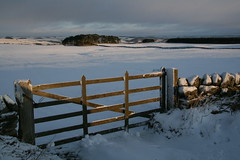 When we set off from Northumberland this morning the mix of sunshine and snow made for some glorious views, but from Carlisle we were racing bad weather on the way down. Somewhere between Penrith and Lancaster the snow caught up with us, and that made for a difficult journey down the M6 through the south of Cumbria and the north of Lancashire.
When we set off from Northumberland this morning the mix of sunshine and snow made for some glorious views, but from Carlisle we were racing bad weather on the way down. Somewhere between Penrith and Lancaster the snow caught up with us, and that made for a difficult journey down the M6 through the south of Cumbria and the north of Lancashire.In the end, we arrived home safely, and things could have been a lot worse. The most sensible thing might have been not to travel at all, but that would have caused other problems. In practice, when things were difficult, everyone on the road was being very sensible, and like our fellow travellers, we just took things slowly through the difficult sections until the weather improved, and the road cleared.
It was certainly an experience, but not one that I'm keen to repeat any time soon.
Saturday 12 December 2009
The famous Wallendas
THE FAMOUS WALLENDAS
"Circus enthusiasts the world over have been thrilled by the great Wallendas."
"Their sense of balance is nothing short of amazing"
"If they weren't actually doing it before your eyes you would think it was impossible"
From British Pathé in 1937
Friday 11 December 2009
Bike lanes
Wednesday 9 December 2009
Free tax advice for entrepreneurs
Monday 7 December 2009
Kippers
According to Office of National Statistics the North Sea herring population was seriously affected by over-fishing in the 1970s. Fishing was stopped between 1978 and 1982 and this allowed stocks to recover. From the late 1980s there was another decline, but things recovered from the mid-1990s. In 2004 the stock was at the highest level recorded for 40 years.
Unfortunately stocks declined in 2005, and according to Cefas the decline has continued since. Cefas say that North Sea herring stocks have shown enormous fluctuation in the past, but the stock is currently assessed as being at risk of reduced reproductive capacity and being harvested unsustainably.
My two kippers earlier this year shouldn't have done too much harm, but the EU is still limiting the amount that can be caught.
 Let's hope things get better for the poor herring in future, so that we can continue to enjoy the occasional kipper from Craster.
Let's hope things get better for the poor herring in future, so that we can continue to enjoy the occasional kipper from Craster.
Sunday 6 December 2009
Crikey, I'm turning into Norman Geras
"There was a Guardian editorial in praise of Paul McCartney, and it gave as an example of his 'effortlessly fluent' lyricism the second line of 'Penny Lane', which it rendered thus:
No, I said to myself, that's not right. And I Googled for confirmation. But instead of confirmation, I got disconfirmation and this:
In Penny Lane there is a barber showing photographs
Why bother?
 Tracing stuff for OSM is an excuse to get out on the bike, get some relaxing exercise, explore places that I wouldn't otherwise visit, and learn a bit more about the area where I now live, and its history. As I add stuff, I tick it off my list of local things that are missing from the map, because doing this also satisfies my urge to see things completed. I also like to think that I am sharing something which is going to be of value to others. So my reasons aren't entirely selfish.
Tracing stuff for OSM is an excuse to get out on the bike, get some relaxing exercise, explore places that I wouldn't otherwise visit, and learn a bit more about the area where I now live, and its history. As I add stuff, I tick it off my list of local things that are missing from the map, because doing this also satisfies my urge to see things completed. I also like to think that I am sharing something which is going to be of value to others. So my reasons aren't entirely selfish. Friday 4 December 2009
Pubs

Saturday 28 November 2009
Fungi
Wednesday 25 November 2009
Previously on Hampden...
Tuesday 17 November 2009
Sunday 15 November 2009
John Hampden
 This is John Hampden, who was a 17th century politician. He played a leading role in early parliaments, and he was killed during the civil war. I can't help feeling that I should know more about him, but I don't. These people do though.
This is John Hampden, who was a 17th century politician. He played a leading role in early parliaments, and he was killed during the civil war. I can't help feeling that I should know more about him, but I don't. These people do though.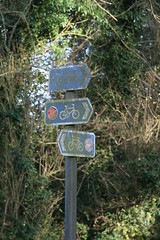 This was the local council's Millennium project, so there has been plenty time for moss to grow on the signs. Helpfully that shows which way we are heading because moss always grows on the north side. Or is it the south?
This was the local council's Millennium project, so there has been plenty time for moss to grow on the signs. Helpfully that shows which way we are heading because moss always grows on the north side. Or is it the south?Either way it is a nice route, through some pretty villages, with some good views. I covered most of it today, and I look forward to going back soon to do the rest.
Wednesday 11 November 2009
Monday 9 November 2009
£10m cycling investment
There is a lot of information on the DfT web site, and I haven't read it all yet: the press release, an assessment of the first wave of cycling towns, and the guide for local authorities.
House rules
Connoisseurs of the unique Daily Mail take on the world ought to examine the house rules for commenting on their web site, before reading this article on cyclists (link provided by Real Cycling).
- “We want our readers to see and understand different points of view”
- “You can express a strong opinion but please do not go over the top”
- “You must not make or encourage comments which are: defamatory, false or misleading; insulting, threatening or abusive; obscene or of a sexual nature; offensive, racist, sexist, homophobic or discriminatory against any religions or other groups"
- "You must not pretend to be someone else (e.g. an expert....)"
Saturday 7 November 2009
Ashmolean, Oxford
Off we went, and we were delighted. We feared that it would be too busy, but it easily absorbed the influx of visitors, and the new displays are wonderful. It would be hopeless to try and describe everything, so I will just say that if you get the chance you should go and see for yourself.
After a few hours we had taken in all that we would cope with, so we went for lunch, had a long walk, and then dropped into another favourite (Pitt Rivers Museum), before heading home.

It was a very good day.
Thursday 5 November 2009
Utterly depressing Flickr group
Tuesday 3 November 2009
Argleton
View Larger Map
Good things here
Monday 2 November 2009
Sunday 1 November 2009
Dinosaurs
The reconstructions were based on fossils from the Natural History Museum, and skeletons of modern animals. They predated the publication of Darwin's Origin of Species by several years, and at the time were controversial. Within 40 years, science had moved on, and the models were recognised as being unrealistic. They fell into disrepair, but were restored in 2002, and were grade-1 listed in 2007.
When I was a child I had a dinosaur book with pictures of these, and I have waited for almost half a century to see the real thing. Today I finally made it. After all that time, I was prepared to be disappointed, and slightly surprised that I wasn't.
There's more here, here, here, here, and elsewhere.
Saturday 31 October 2009
Halloween
I decided to map the bits of Binfield that were still missing from OSM. Around here, Bracknell is one of the few areas with relatively low coverage on OSM, but taking on the town itself looked a bit daunting. Binfield is a village on the edge of Bracknell, and it looked a more manageable size.
A half day outing, and a 25 mile ride got me out there, around most of the areas that were missing from the map, and back home again. The journey there and back was very nice, with the trees looking particularly gorgeous this year. But if anyone from Binfield reads this, I hope they will forgive me for saying that, while it seems pleasant enough, it's not a particularly interesting destination. The biggest novelty was discovering how many houses had been decorated for halloween. There were huge spiders, gigantic webs, gravestones in the gardens, and stuff like that all over the place. I don't remember seeing anything like it before.
Now I am home I've added the traces of the roads (but not the spiders) to Open Street Map. At the level of detail that I collect, I think Binfield is pretty much complete. So next time I feel like a half day filling gaps on the map I fear it will have to be Bracknell itself. Unless I come up with a better idea by then.
(PS the picture has nothing to do with Binfield, but it seemed appropriate for the date)
SMIDSY
Friday 30 October 2009
Thursday 29 October 2009
Milton route, the clod's cut

Cycle map has now rendered my efforts last weekend to trace the Milton Cycle Route in Buckinghamshire. As a result I can now see where I made a couple of errors (paradise lost). I've fixed them in the database today, but it will be another week before it is rendered again, and I won't see whether the fixes worked (paradise regained) until next thursday. Meanwhile the glitches are almost cunningly hidden by a page curl in the image above. They will be visible to all on the tile server for the next week.
Monday 26 October 2009
Visualising traffic data
I'm not sure if it is the original quality of the video, or a lot of activity slowing down the server, but this is a bit difficult to view. It's worth the effort though, for some stonking visualisation of traffic data.
Sunday 25 October 2009
Milton route, director's cut
Apart from getting caught in one shower, and a bit of a gusty wind today wasn't at all bad for a ride; and because of the clocks going back I managed to make quite an early start, and for once I was home in plenty of time for dinner.
The route meanders around Penn, Amersham, Chorleywood, and the Chalfonts. I rode through Beaconsfield on the way there and back. Some of the best parts were riding through autumn woodland, particularly here in Philipshill Wood. At one point I got mixed up with a bunch of runners, who were involved in a big event. Lots of people had come out to cheer then on, and for several miles it felt as though I had a crowd of supporters.
I enjoyed the day, but I have mixed feelings about the route itself. It covers an interesting variety of landscape and some pleasant towns and villages. But there are too many suburbs for my liking. It's probably inevitable in the Chilterns that the route is quite hilly, but it is also a bit complicated. There were too many junctions where I needed to check the map, and so many changes of direction that it was difficult to keep track of where I was heading. There are several off-road stretches that don't really work with a road bike, and although they could be bypassed, that would mean missing some of the best parts of the ride.
The route borders on a number of fairly large towns, and I suspect it would suit someone who lived locally, who wanted to get to know the area better. Coming from further afield, there are more interesting alternatives.
Thursday 22 October 2009
Improving road safety for pedestrians and cyclists in Great Britain
The following exchange pretty much captures the tone....
- Q18 Mr Curry (MP for Skipton & Ripon): No, you have got the wrong question, I am sorry. Why are cyclists such irresponsible and arrogant road-users? The only time I have been knocked down in my life was by a cyclist going like a bat out of hell outside the House of Commons, dressed like Darth Vader, as they all do! Many people think that cyclists are hugely irresponsible, that they do not take any notice of the red lights, they think that road traffic cones are not for them, it is very competitive and that they are dangerous.
- Mr Devereux (DfT Permanent Secretary) There are, without doubt, some elements of the cycling community who are in that position and there are equally, I imagine, rather more people who are far more dangerous drivers as well. The population is not homogeneous, as you well know, and cyclists—
- Q19 Mr Curry: If a cyclist or any driver of a car drove his car like cyclists ride their bikes, there would be nobody left on the roads of Britain at all.
- Mr Devereux: Sorry, you are assuming that all cyclists cycle the way the dangerous cyclist who went past you—
- Q20 Mr Curry: No, I am not. I am saying that far too many are. We seem to regard cyclists as living in some sort of superior moral category when they actually do not have any.
- Mr Devereux: I do not accept that.
Tuesday 20 October 2009
'tis the season...

..for the press to publish articles about cycling in winter weather.
This morning I turned to one in today's Guardian, but it's almost all about fashionable winter cycling clothes. I've already got my gloves to keep my hands warm, and an old anorak to keep the rain off. I think I would look silly in a furry cycling helmet (some would say I look silly enough without one). I might convince myself that I need something more conspicuous for safety on dark evenings, and I've been thinking about investing in a proper winter top, but I've already been mulling that one over since last autumn.
What I really need as the weather changes is plenty of good reasons to brave the elements and get out on the bike.
Sunday 18 October 2009
Milton route revisited
It was a lovely day for a ride. A little bit nippy, but it was nice sunny autumn weather, and this part of south Buckinghamshire is pleasant. Not all of the route is great, but the woodland where I lost my way yesterday was particularly nice, and I rode through some pleasant villages.
Paradise would be putting it a bit strong, but I didn't get lost. So "Pleasant countryside navigated successfully" would be a bit more accurate than "Paradise Lost". If only John Milton had worked harder on his cadence and navigation skills, and wasted less time on blank verse he might have made a name for himself.
Saturday 17 October 2009
Milton Route
 What with a weeks holiday, backlog at work, and various other distractions my cycling log is all going a bit pear shaped. I've fallen behind plan again, and this weekend I'm making a concerted effort to get things back on track. I need to cover a lot of miles, and I am out of practice.
What with a weeks holiday, backlog at work, and various other distractions my cycling log is all going a bit pear shaped. I've fallen behind plan again, and this weekend I'm making a concerted effort to get things back on track. I need to cover a lot of miles, and I am out of practice.Today my plan was to trace the Milton Route in Buckinghamshire. It should have been a ride of about 50 miles - but it didn't quite work out like that.
I got myself to Seer Green easily enough, and headed off westwards for Penn. When I eventually arrived in Chalfont St Giles (to the north) I realised something was wrong. A quick check on the map, change of direction, and I headed off for Jordans to the south). When I arrived in Chalfont St Giles for a second time I realised something was still wrong.
Saturday 10 October 2009
Simpson lever chain
The Simpson Lever Chain was invented by William Spears Simpson in 1895.
"The tops of the triangles had cross bars that engaged the perimeter of the rear chain wheel's flange at a much greater distance from the wheel's axis than would an ordinary chain and chain wheel. Thus Simpson could claim that his chain provided more power through greater leverage.
In the fall of 1895, Simpson offered ten-to-one odds that riders with his chain would beat bicyclists with regular chains. Later known as the Chain Matches, these races at the Catford track in London attracted huge crowds estimated between twelve and twenty thousand in June of 1896. Simpson's team not only included the top racers - Tom Linton, Jimmy Michael, and Constant Huret - but also the Gladiator pacing team brought over from Paris. Pacers enabled a racer to ride faster by shielding him from air resistance. Although Simpson won the Chain Matches, they only proved that the Gladiator pacers were superior to their English rivals."
There is more about the Simpson chain here and here. There is a very clear explanation in French here (roughly - "it is composed of a series of triangles. The inner hinges of the chain engage with the gear at the pedals, and the outer ones with the rear wheel").
"If it has merits, now is an appropriate season to consider its possible future influence. If it has none, it will disappear into the limbo of forgotten novelties."
And it did.
Cycle show
The biggest stands from major manufacturers didn't seem quite as big as last year, but there were a lot of specialised products of different kinds; lots of folding bikes, and fixies; several different electric bikes; and what felt like a lot of retro design.
There was quite a bit of cycle mapping. I bought some Sustrans route maps to help work out which trip to do next spring, and I picked up a few TfL cycle maps for weekend outings. There were digital maps from Memory Map; and GPS devices from Garmin and others. I had a bit of a play with a Garmin Oregon loaded with OS maps. It seemed nicely designed, and easy to use, but suspect it is of more practical use to walkers. Before buying one I would need to be convinced that I could read it while riding a bike. OSM cycle maps on a Garmin don't include all the detail that you get on an Ordnance Survey map, but that seems to be a good thing when you are on the move.
I can't help feeling that the most interesting parts of the show were the slightly odd-ball stands, like the exhibits from the National Cycling Museum - which was one of the busiest stands I visited.
These bikes for the London Cycle Hire scheme were shown on the TfL stand. They look very smart, but a bit heavy. I was told that they ride better than you would expect from looking at them. It will be interesting to find out for myself next year.
Wednesday 7 October 2009
And how right they are
Sunday 4 October 2009
Off-grid
Where we stayed there was no mobile phone signal, and no broadband connection, which has been a bit weird. I hadn't realised how much I've begun to rely on the internet to check bits and pieces, like how long it will take to get somewhere, and whether it will be open when we arrive.
There is quite a bit of Northumberland that still needs to be added to OSM. Others are making more useful contributions, but I thought I might be able to do a little bit, and I did manage to collect a few GPS traces. I wasn't very systematic about it though, so I haven't added a huge amount. Just the odd street, and a few other details.
Wednesday 23 September 2009
Longish day, shortish ride
Tuesday 22 September 2009
Monday 14 September 2009
My first 100 mile ride
I must start by thanking Mike for talking me into this, for coaching me beforehand, and for supporting me patiently through the ride.
By the time we were a third of the way round most of the serious cyclists had whizzed past us, and the rest of us plodded steadily on. The route had been well thought out, it was clearly signed, and well marshalled. It was more hilly than I had expected, but we went through lovely countryside, and some pretty villages. On the way down to Salisbury the weather was perfectly cool and sunny. But after a break, as we worked around Salisbury Plain, the sky clouded over and we hit a bit of a head wind. However, once we reached Devizes the wind had died down again, and I managed a quick turn of speed. After that I was beginning to get seriously tired, but the miles clicking down kept me going. In the final couple of miles It was no surprise when I had to get off and push up Brassknocker Hill. I made it to the end though, and I wasn't the last to finish.
I had a great day, and judging by the state of my legs I might come out of this a bit stronger. But I suspect the real difference is what's changed inside my head. Eighteen months ago, I thought 30 miles was a long ride. A year ago the longest ride I had done was 60 miles, and my average ride was about 15 miles. This year (up to now) I've been quite pleased to do a 50 mile ride almost every week, with an average ride of 25 miles or so. Yesterday has raised the bar. I doubt if I'll do 100 miles very often, but now 50 miles doesn't seem so far. Despite some friendly ribbing I'm not going to be investing in lycra, but I already knew I should work harder on my speed, and yesterday also confirmed that.
Family, friends and colleagues have been generous with encouragement and sponsorship. The organisers and other participants helped to make it an enjoyable day, and Mike made it possible. I normally like to plan my own routes, take my own time, and enjoy my own company on a ride. But yesterday was a reminder that it can sometimes be good to share the experience.
Thursday 10 September 2009
Harding route (2)
 Last Saturday I tried to ride round the Harding cycle route near Amersham. I knew I went a bit adrift in a couple of places, but I marked up the sections that I was confident in on OSM. The bits that I plotted have now been rendered on the cycle map. Although it is incomplete I'm quite pleased with the result.
Last Saturday I tried to ride round the Harding cycle route near Amersham. I knew I went a bit adrift in a couple of places, but I marked up the sections that I was confident in on OSM. The bits that I plotted have now been rendered on the cycle map. Although it is incomplete I'm quite pleased with the result. Tuesday 8 September 2009
NHT on routes
 Fans of the OSM cycle map might be interested to see how different local authorities are rated in the NHT survey for the information they provide on cycle routes. Darlington comes out well in the survey, and Liverpool does not come out well at all.
Fans of the OSM cycle map might be interested to see how different local authorities are rated in the NHT survey for the information they provide on cycle routes. Darlington comes out well in the survey, and Liverpool does not come out well at all. Monday 7 September 2009
NHT
 I've just noticed that the 2009 data from the NHT survey are now available. I'm not sure how long they have been there, but I just found them this morning. The NHT survey is a postal survey on transport facilities carried out by IPSOS MORI for a number of local authoritites. Seventy-seven took part in 2009, covering a fair chunk of England, but not including my own local council.
I've just noticed that the 2009 data from the NHT survey are now available. I'm not sure how long they have been there, but I just found them this morning. The NHT survey is a postal survey on transport facilities carried out by IPSOS MORI for a number of local authoritites. Seventy-seven took part in 2009, covering a fair chunk of England, but not including my own local council. The survey asks a number of questions about how the public sees different aspects of road and transport services, including cycling facilities.
Sunday 6 September 2009
Harding Route
I didn't stay long in Amersham, setting off to ride the "Harding Route". This is named after Thomas Harding, a 16th century religious dissident and martyr. He was a follower of Wycliffe, or a "Lollard" who was sentenced to be burned for his religious beliefs and so tied to a stake at Chesham. Apparently, the priests told people that if they brought wood to burn heretics they would have an indulgence to commit sins for forty days. Once they had lit the fire, someone beat his brains out with a stick.
Happy times.
Anyway, the Harding Route is one of three 25 mile "Heritage" rides around Amersham. This one runs to the north and east. I think they were set up as a millenium project, and they seem to have been well thought out. Certainly this one goes through some nice countryside, and some pretty villages. It's towards the "strenuous" end of my normal range, which means it's hilly enough to be interesting, and then some. Combined with a few tough climbs on the way out to Amersham and the same coming back, I ended up covering just over 60 miles, and by the time I got home I certainly knew I had been for a ride.
The route is reasonably well signed, though some of them are a bit hard to spot. I had to retrace my path a couple of times, and I know I drifted off it at one point. I'm still not sure which bits I followed accurately. As far as I can tell, all the roads I followed are already on Open Street Map, but the cycle route is not marked as such on the map. It shouldn't be too difficult to add it - but I think it's going to need at least one more circuit to be confident of getting it right. Meanwhile the official map is here.
Friday 4 September 2009
The Economist

This week's Economist has an article about digital maps which is quite interesting, except it manages to avoid mentioning OSM. I can't leave a comment on their site without registering, and someone else has already made the point nicely. So this is my contribution.
Wednesday 2 September 2009
Apology from Wired
Apparently their legal team interprets the Creative Commons "noncommercial" license as allowing editorial use in news stories. I find that a bit surprising, but who am I to argue?
Tuesday 1 September 2009
August round-up
In the last four months I've also completed this year's Jenkin's quest. Meaning that since the beginning of last year I've used the bike to visit 25 of the best English churches ranked by distance from home. Every time I reach one the distance to the next is a bit further. Each round-trip is now approaching 60 miles, so I've put that project to one side until next year.
So my longer weekend trips are now a mixture. I've been taking advantage of return trips on the train to reach more distant centres, such as Oxford and Winchester, which encourage me to explore new routes. I've also been trying to map some of the gaps in OSM, which means I'm learning more about the local area. And I've fitted in a few interesting destinations and routes, like the Wey Navigation.
Overall I'm covering greater distances, in fewer, longer rides. I hadn't ridden 100km until earlier this year, but now I've done it five times. I've covered my age in kilometres 25 times, and in miles 11 times this year. So my Eddington number is up to 40.
I'm planning to do a 100 mile ride in a couple of weeks time, and that will be the next big challenge. Meanwhile I'm quite pleased with how things are going. My fear was that I would lose interest, and things would tail off, but there's no sign of that happening. Just the opposite. As the rides get more demanding they get more interesting. Where will it all end?
Monday 31 August 2009
Turville & Hambleden
 A nice ride this afternoon joining up bits of recent rides with an old favourite, for a 38 mile loop round Henley, Christmas Common, Turville, Hambleden and Marlow. After a grey morning the weather turned sunny and wam this afternoon. It was a little bit windy, but otherwise nothing to grumble about.
A nice ride this afternoon joining up bits of recent rides with an old favourite, for a 38 mile loop round Henley, Christmas Common, Turville, Hambleden and Marlow. After a grey morning the weather turned sunny and wam this afternoon. It was a little bit windy, but otherwise nothing to grumble about.Saturday 29 August 2009
When possible make a U-turn
Saint Pancras
Friday 28 August 2009
Wired
I quite like Wired, so I am hugely flattered that they chose my picture, and pleased that they have attributed it. But I'm a bit surprised that a publication like that didn't take more care over the license restrictions, which specify "non-commercial use".
I've emailed them to that effect, offering to send details of where to send payment, if only in recognition of the importance of the licensing system, and the rights of commercial photographers. I will report results.
Sunday 23 August 2009
Arbitrary and meaningless?
Saturday 22 August 2009
A day at Ascot
Friday 21 August 2009
OSM coverage in Scotland and Wales
Name |Coverage
Isle of Anglesey | 124%
Gwynedd | 71%
Conwy and Denbighshire | 54%
South West Wales | 60%
Central Valleys | 43%
Gwent Valleys | 35%
Bridgend and Neath Port Talbot | 65%
Swansea | 77%
Monmouthshire and Newport | 72%
Cardiff and Vale of Glamorgan | 79%
Flintshire and Wrexham | 87%
Powys | 50%
Angus and Dundee City | 56%
Clackmannanshire and Fife | 51%
East Lothian and Midlothian | 65%
Scottish Borders | 60%
Edinburgh, City of | 99%
Falkirk | 55%
Perth & Kinross and Stirling | 66%
West Lothian | 64%
East Dunbartonshire, West Dunbartonshire and Helensburgh & Lomond | 66%
Dumfries & Galloway | 51%
East Ayrshire and North Ayrshire mainland | 42%
Glasgow City | 86%
Inverclyde, East Renfrewshire and Renfrewshire | 70%
North Lanarkshire | 55%
South Ayrshire | 48%
South Lanarkshire | 58%
Aberdeen City and Aberdeenshire | 46%
Caithness & Sutherland and Ross & Cromarty | 64% *
Inverness & Nairn and Moray, Badenoch & Strathspey | 64% *
Lochaber, Skye & Lochalsh, Arran & Cumbrae and Argyll & Bute | 64% *
Eilean Siar (Western Isles) | 67%
Orkney Islands | 29%
Shetland Islands | 48%
(*) = Average across three regions
Thursday 20 August 2009
OSM coverage in Scotand and Wales

I've had a first attempt at measuring OSM coverage in Scotland and Wales using NUTS-3 regional boundaries as the common ground to compare Department for Transport statistics on the length of roads in a local authority against the length of roads plotted on OSM.
NUTS is the basis on which the EU publish regional statistics, and they provide the boundaries as shapefiles. The precision isn't as great as you get from admin boundaries on OSM, so this is a stop-gap until the boundaries for local authorities in Scotand and Wales are complete on OSM (or until the Ordnance Survey put them in the public domain).
On the whole the NUTS boundaries match up reasonably well with Local Authority boundaries. In some cases they are the same, in others I can aggregate the road lengths for a few authorities to get the figure for the equivalent NUTS region. It's only in the Scottish highlands where this doesn't work too well, because the local authority for the Highlands crosses several NUTS regions. So I needed to take an average across a big area of northern Scotland.
Nobody seems to like the colouring on this attempt very much, so that will need some more work. But meanwhile, the headlines are that Anglesey and Edinburgh look well covered. Glasgow, Renfrewshire, and Gwynedd look pretty good. While Powys, Aberdeenshire, Orkney and Shetland are looking a bit thin.
For anyone interested in doing a similar exercise elsewhere in Europe, I don't know what detailed figures are published at national level, but there are Eurostat figures for road lengths at the NUTS-2 level (i.e. the next largest geographical grouping after those I am using here). Eurostat only split "Motorways" and "Other Roads" so dealing with dual carriageways etc is going to be a bit iffy. However, I've done a quick comparison of their numbers for the UK, and the rough figures (motorways * 2 + other roads) gives me a total that isn't a million miles away from more detailed calculations. The Eurostat figures are here under "Regional Transport Statistics", and the Eurostat shapefiles that I used are here
There's another version, with brighter colours here
Monday 17 August 2009
Navigation
From there to the top of the Wey Navigation is on the West London sheet (176) and I checked that one a couple of times, but along the canal itself it only took me as far as the point where the M25 crosses.
Then I was on the Dorking and Reigate sheet (187) almost until I reached Newark lock (in the picture). After that I would have been following the route on the Aldershot & Guildford sheet (186) except that I didn't have a copy of that one.
Not that it particularly matters along a canal of course. Even at my most vague and woolly, it would be quite an achievement to get lost on a towpath. Except for one thing.... approaching Guildford there are a couple of different options, and I suspect I didn't pick the best route into the centre.
Getting home from the centre of Guildford was another matter. My planning for the day had been bit sloppy to put it mildly. Basically I knew that if I headed north I would end up somewhere familiar, and I hadn't given it much more though than that. I've got the OSM cyclemap on the GPS, and since that now has route finding I was pretty relaxed about getting home.
In the event, though, the distance from Guildford to home proved a bit too much for the GPS. I fiddled around with partial routes for a while without too much luck, and in the end I realised I didn't have time to drift much off a straight line, so I went and found a book shop, and bought a copy of the local OS sheet.
That got me as far as Bagshot. Not that it needed much checking since I was now following a main road, with plenty of signposts. From Bagshot I was back on the OS sheet that I had started from, but more importantly, I was on familiar ground, and the GPS route finder was coping, and ticking down the remaining distance. So from Bracknell I was able to call home and let them know (more or less) exactly how late I was going to be.
Unfortunately slippy maps on the internet don't function too well out on the road. The GPS is wonderful, but it isn't really up to finding 20 mile routes on the bike yet (though it is getting there). I am trying to make a convincing case to myself that an Internet tablet with GPS and Maemo Mapper would be just the thing (without much luck). So in reality I suspect that I'm going to be carrying bundles of landranger maps for a while yet.
It seems a bit ironic that all this came to the fore along a canal route call the "navigation".
